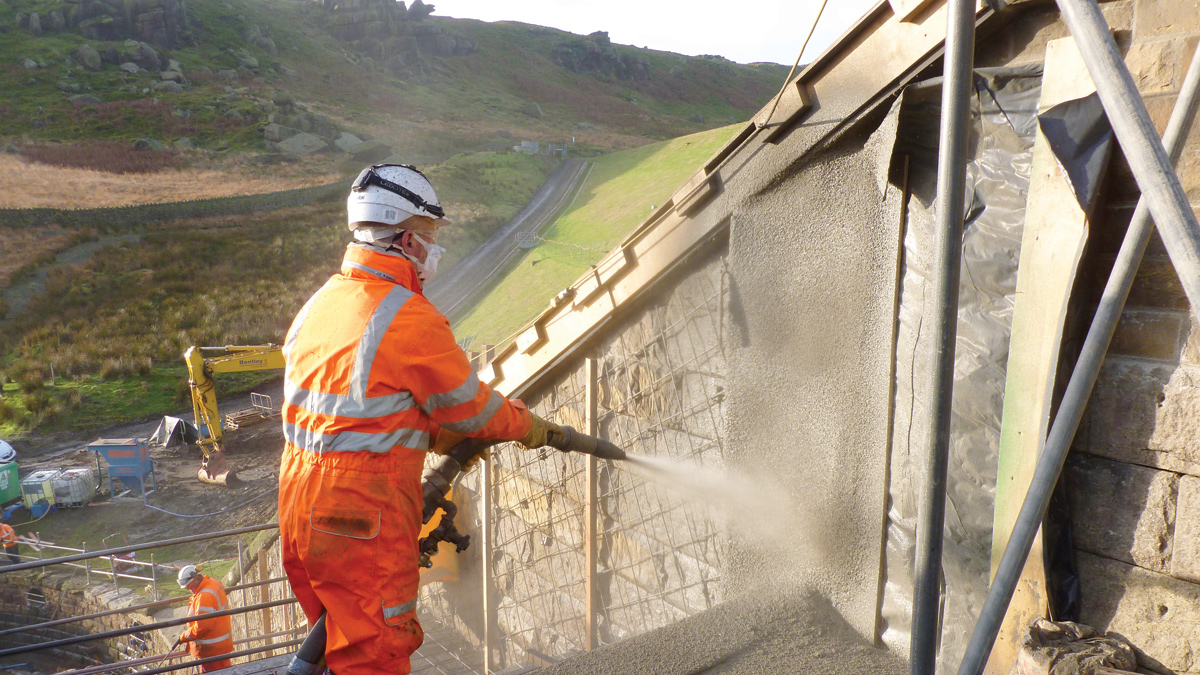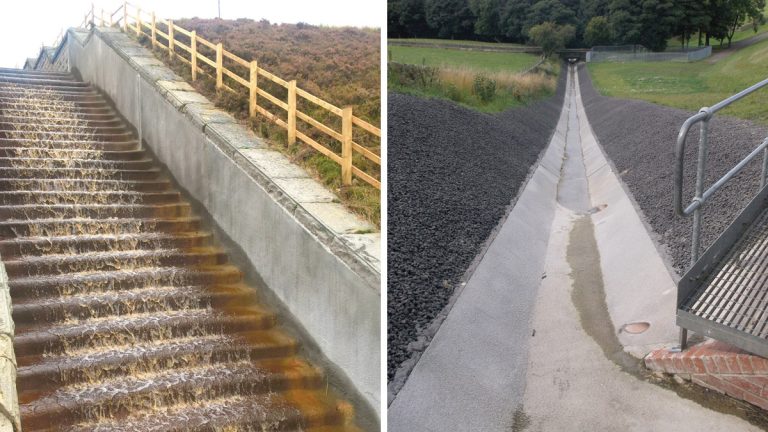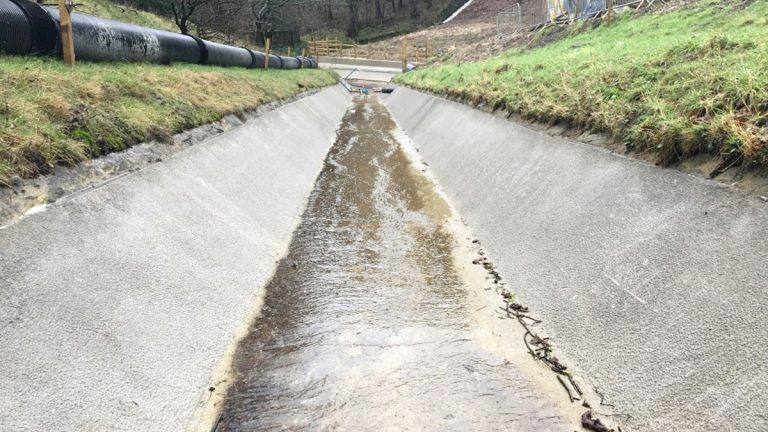Masonry Reservoir Spillway Refurbishment (2017)

Spray-applied ‘shotcrete’ being applied to the existing reservoir spillway walls at Widdop IRE - Courtesy of MMB
The innovative use of a spray applied structural concrete ‘shotcrete’ lining is a cost and programme effective alternative to ‘traditional’ in situ or precast concrete repair, or re-construction of masonry reservoir spillways. This construction methodology was used successfully across three masonry spillways of varying geometries to prolong the operational life of the ageing structures, whilst reducing the risk to reservoir safety resulting from structural failure of the spillway channels, in line with Section 10 of the Reservoirs Act (1975).
Widdop, Eccup and Ardsley Reservoirs
As owner and operator of the three reservoirs, Yorkshire Water Services (YWS) was required to address recommendations regarding measures to be taken in the interests of Safety under Section 10(6) of the Reservoirs Act (1975) at each reservoir. At each reservoir YWS was required to assess spillway capacity during a design (worst-case) flood event and address any identified deficiencies. As framework partner these assessments and the resulting works were delivered by Mott MacDonald Bentley (MMB) for YWS in the first year of AMP6.
The spillways
Prior to these works the spillways at the three reservoirs were as per the original masonry dressed, concrete backed construction:
- Widdop Impounding Reservoir (IRE): Constructed in 1878, the spillway is a steep (max 1:2 gradient), stepped, 4.3m wide x 2m deep rectangular channel.
- Eccup En-route Storage Reservoir (ESR): Constructed in 1897, the spillway is a non-stepped, 4m wide x 1.3m deep trapezoidal channel.
- Ardsley ESR: Constructed in 1880, the spillway is a non-stepped, a 1m wide x 0.25m deep invert section of the trapezoidal channel was lined.
Following the flood assessments, spillway deficiencies were identified, amongst which was the need to address failure of the masonry channel inverts due to ‘pull-out’ of stone setts at high flow velocities (>8m/s), potentially leading to erosion of the embankment and the possible significant impact of failure on downstream communities.
To mitigate this risk, preventative works were required to the full length (Ardsley) or sections (Widdop and Eccup) of the spillway channels. Historically on similar schemes previously delivered by MMB for YWS, the level of prevention of masonry ‘pull-out’ has been achieved by the use of in situ or precast concrete (PCC), either by lining within or replacing the existing channel structure entirely.
Given the typical location and topography of reservoir spillways, construction by these methods is inherently complex and expensive, with a number of high risk construction activities involved. In all three cases the masonry channels were found to be structurally sound, so an efficient option was sought to limit the extent of re-construction work and extend the life of the existing channels.
This approach was considered to be the most sustainable; limiting demolition works and the associated impacts of dealing with arisings for recycling or disposal.

(left) Widdop IRE post completion and (right) Ardsley ESR post completion – Courtesy of MMB
(left) Widdop IRE post completion and (right) Ardsley ESR post completion – Courtesy of MMB
Optioneering exercise
In line with the specific scope determined for each scheme, an optioneering exercise was undertaken to directly compare the spray applied structural concrete with the in situ and precast methods previously used. The rounded assessment considered health and safety, cost, programme, sustainability and longevity, amongst others. Whilst the capital cost of the spray concrete application was higher than that of the traditional methods on a pro-rata (per linear metre) basis, when the associated construction programme reductions were considered significant, cost savings were identified.
Spray concrete
The use of high pressure, spray applied concrete in a confined, steep spillway channel creates health and safety hazards that need to be managed through clearly defined working procedures. However, in comparison with traditional methods, a greater number of risks and hazards are removed, such as lifting large PCC units or shutters on steep slopes. In close liaison with the appointed specialist spray concrete subcontractors, working methodologies were developed to mitigate the risks, such as the deployment of travelling fall arrest and restraint equipment. A dry spray application method (powder pumped and mixed with water at the nozzle) was chosen over a wet spray method (pumped wet) to reduce the manual handling hazard, provide a better finish and improve quality control.
Despite there being limited evidence of spray concrete being used in this application before (MMB had undertaken an emergency lining of a spillway for YWS prior to decommissioning in AMP5), YWS was willing to support the innovation due to the efficiencies supporting their aim of delivering value for their customers. This wasn’t just considered for these three schemes, but as a potential saving for similar schemes in future years. In comparison with a typical in situ (300mm thick section) or PCC (150mm thick section) construction, significant materials savings are made when a thin spray concrete (85mm thick) is used. The reduction in materials deliveries, twinned with the remote location of some of these sites led to a large reduction in embedded carbon, another key driver for the client.
The design proposal was required to achieve a finished product that met the initial scheme driver (spillway resilience), the technical requirements of the client and most importantly would be robust and provide the longevity required: the spillways are required to operate for a minimum of a further 80 years in harsh, remote environments. The decision was made that the design proposal would match across the three projects despite their differing geometries.

Eccup ESR spillway post application – Courtesy of MMB
To provide confidence to the client and the qualified civil engineers (QCE) overseeing the reservoirs, a design was produced that addressed the high flow velocities (scour and uplift), freeze/thaw attack, thermal action, failure of the existing masonry structure beneath the spray lining and water ingress in the boundary layer. This determined a minimum 85mm thick layer of proprietary C32/40 fibre reinforced concrete, reinforced with A193 mesh and dowelled to the existing masonry substrate at 1m centres. Thermal joints were provided throughout the section at 15m centres, with proprietary Hydrospan Watertight polyethylene foam guarded by a GRP plate.
Application of the product was carried out in accordance with the ‘European Specification for sprayed concrete: EFNARC 1996’ including a bespoke, comprehensive quality control regime developed with the subcontractors and the client. Application at each of the sites was carried out during the 2015/16 winter due to programme constraints, which was one of the wettest winters on record. Control of water ingress into the channels from surrounding ground caused the works to be paused on a number of occasions to maintain application quality.
To maintain the programme dates the methodology was revised to include a thin ‘blinding’ layer of rapid setting spray-applied mortar to prevent further ingress prior to the main application. All three schemes were successfully signed off in mid-2016.






